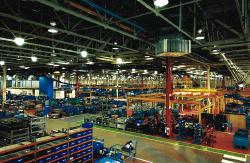Ventilation as a free benefit

Delivering fresh air at the same time as providing space heating is a cost-effective and energy-efficient approach to delivering indoor air quality in industrial premises.
Ventilation is essential to maintaining good air quality in industrial buildings. The good news is that ventilation can be integrated in the heating system to avoid additional expenditure on separate ventilation plant. Alan Dorsey explains.Air quality in industrial buildings can soon deteriorate once production gets into full swing. Certain industries are prone to airborne particles that can make life unpleasant for employees. Automotive manufacturing processes, for example, produce oil haze that hangs in the air. In other industries, chemical processes may produce unpleasant vapours or airborne dust.
Minimum COSHH regulations require, as a minimum, ‘a good standard of general ventilation and good working practice’, particularly when working with substances hazardous to health. For hazardous substances, extract ventilation will usually be required. For other areas a good level of ventilation that will maintain air quality can be achieved easily and cheaply — without the need for additional equipment, but simply through the heating system. The technology of combined-heating-and ventilation (CHV) solutions has been developed to offer optimum energy efficiency while improving air quality. CHV systems rely on a degree of fresh air intake for their operation. Nordair gas-fired CHV units, for example, work on a patented air-input system which varies the amount of fresh air required to meet changing building criteria. The amount of fresh air is controlled by air quality sensors, carbon-dioxide sensors or temperature sensors, depending on the criteria to be met.
Optimum control Combining heating and ventilation gives optimum control and avoids the problem of co-ordinating and balancing separate heating and ventilation units. The combined system has significant benefits on heating operation, since it utilises a large air volume/low discharge temperature principle. When operating in heating mode, CHV units provide a controlled amount of fresh air to the building. This slightly pressurises the air inside the building and enables large spaces to be heated without the need for distribution ductwork. Pressurisation distributes the air evenly throughout the building, eliminating temperature stratification at high level and providing even lateral temperature distribution. A modulating burner and damper system, controlled via a microprocessor, co-ordinates heating and ventilation.
Reduce temperatures Where heat gains from processes cause overheating during winter, the units can supply tempered fresh air to reduce internal temperatures without the discomfort of introducing untreated cold air. During summer, full fresh air can be provided. Where an air-extract system is installed to remove hazardous vapours or dust, a balanced supply of input air is required to ensure that the extract works efficiently. The need is to maintain a precise air and temperature balance in the building even though the extract rate may vary throughout the day. Such a system is controlled by pressure sensors that detect changing conditions and vary the supply-air volume to maintain a very slight pressure in the building. This close control maximises operating efficiency of the extract system whilst minimising gas and electrical consumption of the supply-air plant. A recent installation for a large automotive involves 12 CHV units each with a rated air volume of 25 m3/s. The system provides the sole means of heating for the plant and balances the air-extract systems from the process and painting areas. The building pressure sensors detect when the large loading doors are opened, and the system responds to minimise the influx of cold air. Significant improvements to the internal environment in summer have been achieved by operating on full fresh air.
Cost effective Intelligent combined heating and ventilation units are an ideal cost-effective and fuel-efficient solution for a variety of industrial applications, sports arenas, aircraft hangars and exhibition halls. Nordair CHV units, for example, are eligible for Enhanced Capital Allowances, making it possible for end users to offset all the capital cost against corporation tax in the first 12 months. The beauty of CHV systems is that they can ensure every part of the building is usable at all times. There are no cold spots since heat is distributed evenly and without the need for destratification fans. When temperatures in the building change, the CHV system can respond very quickly to restore comfort conditions. Best of all, the cost of a highly effective, economical and fuel-efficient heater, ventilation comes free.
Alan Dorsey is with Nordair, Unit 22, Battersea Road, Heaton Mersey Industrial Estate, Stockport, Cheshire SK4 3EA.
Related articles:


